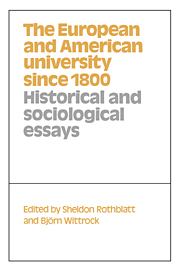Book contents
- Frontmatter
- Contents
- Notes on the contributors
- Introduction: universities and ‘higher education’
- Part I Fact and ideals in liberal education
- Part 2 The State, the university, and the professions
- Part 3 The ambiguities of university research in Sweden and the United States
- Part 4 Complexity
- 7 The problem of complexity in modern higher education
- 8 Comparative perspectives on British and American higher education
- Part 5 The ironies of university history
- Index
8 - Comparative perspectives on British and American higher education
Published online by Cambridge University Press: 04 August 2010
- Frontmatter
- Contents
- Notes on the contributors
- Introduction: universities and ‘higher education’
- Part I Fact and ideals in liberal education
- Part 2 The State, the university, and the professions
- Part 3 The ambiguities of university research in Sweden and the United States
- Part 4 Complexity
- 7 The problem of complexity in modern higher education
- 8 Comparative perspectives on British and American higher education
- Part 5 The ironies of university history
- Index
Summary
Introduction
It is common knowledge that Harvard College was created on the model of a college of Cambridge University. But we know also that almost from the first moment, American forms of higher education began to diverge from the English model – and that divergence has continued apace over three and a half centuries. Already by the time of the American Revolution the colonies had eight institutions of higher learning, while two were still adequate for the much richer and more populous mother country. And by the Civil War the United States had hundreds of colleges and universities. Four – the two ancient universities plus Durham and London – were all that England had chartered. There were additionally four universities in Scotland, and two – Trinity College, Dublin and Queen's University – in Ireland. Owens College, Manchester had been established as a university college as the first of a number of university colleges which much later were to be chartered as separate degree-granting universities. But while higher education in Britain has continued to grow, it has done so within the firm constraints of central government and its criteria for the chartering of universities and other degree-granting institutions.
The divergence has continued, so that England, while currently moving toward some form of mass higher education, still has a relatively small system of degree-granting institutions – universities, polytechnics, and colleges, with relatively high and common standards for the first degree and low rates of attrition, enrolling the smallest proportion of the age grade, just under 15 per cent of any modern industrial society.
- Type
- Chapter
- Information
- The European and American University since 1800 , pp. 280 - 300Publisher: Cambridge University PressPrint publication year: 1993
- 5
- Cited by



